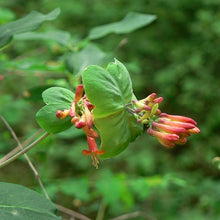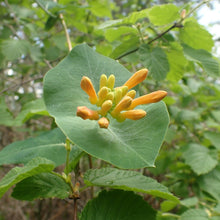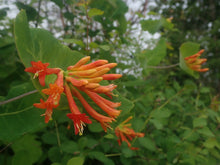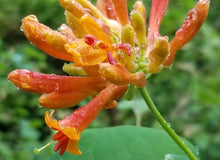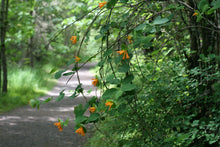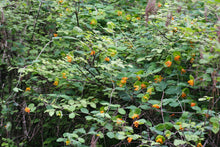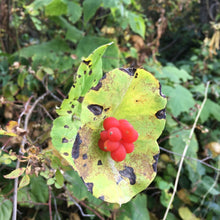
Lonicera ciliosa
Orange honeysuckle is one of the very few species of native northwest vines. It’s one of the most potent hummingbird attractants, with its lightly-fragrant, tangerine-toned, trumpet-shaped flowers. And, as the name suggests, it is also favored by children who have adored sucking the sweet nectar from the base of the flowers for longer than anyone could possibly know. Beyond hummingbirds, the flowers will entice a plethora of insect pollinators, the vines provide nesting and refuge opportunities in spring and summer, while the orange-red berries are an excellent source of food for birds and small mammals in fall.
- Plant type/canopy layer: deciduous, perennial, vine
- Size at maturity: vine can grow up to 30’ long
- Light requirements: part sun/part shade, full shade
- Moisture requirements: moist to dry soil
- Bloom time: April to July (May - July in the Portland Metro area)
- Growth rate/ease: fast growing, moderately easy to grow
- Wildlife support: flowers attract and provide nectar to hummingbirds adult butterflies, bees and other insect pollinators; berries are eaten by a variety of birds including robins, juncos, flickers, and finches; overall plant attracts beneficial and pest eating insects and is a caterpillar host and larval food source for likely over a dozen species of native butterflies and moths including the Variable Checkerspot moth, the White-lined Sphinx moth and the Hitched Arches moth. In Snohomish lore, crows are said to swing on the vines and it is known as “Ghost’s Swing” or “Owl’s Swing” in Coast Salish languages.
- Native habitat/range: relatively common growing in open woodlands, forest edges, north-facing slopes and streambanks, from sea level to 2000m, on both side of the Cascade crest from western British Columbia, throughout western Washington and Oregon, into northern California - but also can be found in the Idaho panhandle and neighboring Montana; and isolated communities in Utah and Arizona. Portland Plant List - yes.
- Special features & uses: hummingbird magnet; drought-tolerant; ethnobotanical uses include using vines/stems as building materials, fiber, twine and as a black dye; medicinally, an infusion of bark or chewed leaf juice has been taken as a cold remedy and to treat sore throats, in reproductive health to strengthen the uterus, stimulate lacteal flow, as contraceptive, as a tuberculosis remedy and a general strengthening tonic, an infusion of crushed leaves can also used externally as a strengthening tonic, especially for children with epilepsy, and as a hair wash to encourage growth, improve hair strength and sleekness, a poultice of chewed leaves can be applied to bruises, vine pieces have been placed under pillows to induce sleep; landscape uses include habitat hedgerows, pollinator gardens and woodland gardens.
Gardening with Orange Honeysuckle: Orange honeysuckle tolerates a range of light and moisture conditions; part sun to full shade and moist to dry soils. That said, as will many species that are so forgiving; the more sunlight it gets, the more moisture it will appreciate. So, plants located in most-to-full sun are more likely to require supplemental water to maintain their vigor in the hot, dry summer months. If it’s not in too much sun, and the soils are rich enough to retain a reasonable amount of moisture, it can be quite drought-tolerant, once established. Example companion plants include creeping vine maple (Acer circinatum), oceanspray (Holodiscus discolor), Oregon grape (Mahonia nervosa), Nootka rose (Rosa nutkana), western meadowrue (Thalictrum occidentale) and fringecup (Tellima grandiflora), and streambank violet (Viola glabella).
In the wild, orange honeysuckle is a sprawling vine. So, be prepared to give it structural support, such as a trellis or arbor, as well as some ongoing training to achieve your desired look. Best case scenario, young happy letting it ramble freely along a fenceline, habitat hedgerow, or through the edges or your woodland garden. Generally honeysuckles are adored by aphids. If this is an issue for you, check curled leaves and spray off with water to remove small infestations. Or just leave them as food for the ladybugs and birds.
Photo Credit 1 (buds): "Lonicera ciliosa 10779" by Walter Siegmund is licensed under CC BY 2.5.
Photo Credit 2 (buds): © giantcicada, some rights reserved (CC-BY)
Photo Credit 3 (orange flower clusters): © Nolan Exe, some rights reserved (CC-BY)
Photo Credit 4 (super close up): © Gail A Baker, some rights reserved (CC-BY)
Photo Credit 5 & 6 (wild vines): Karli Del Biondo, Beetles and Bees
Photo Credit 7 (fruits): © Harry Podschwit, some rights reserved (CC-BY)







